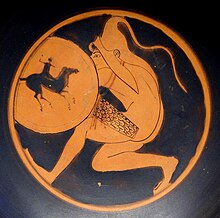
Back Шъхьарыхъон ADY Палчакх CE Baschlik German Baŝliko Esperanto باشلیق Persian Paslikka Finnish Bachlyk French Bašlyk Italian Шъхьарыхъуэн KBD Башлық Kazakh
A bashlyk, also spelled bashlik (Karachay-Balkar: Başlıq, Adyghe: Shkharkhon, Abkhaz: qtarpá, Chechen: Ċukkuiy, Ossetic: Kaskæ Crimean Tatar: Başlıq, Tatar: Başlıq, Turkish: Başlık; "baş" - head, "-lıq" (Tatar) / "-lık" (Turkish) - derivative suffix), is a traditional Turkic, North Caucasian, Iranian, and Cossack cone-shaped hooded headdress, usually of leather, felt or wool, featuring a round topped bonnet with lappets for wrapping around the neck. Local versions determine the trim, which may consist of decorative cords, embroidery, jewelry, metallized strings, fur balls or tassels. Among dozens of versions are winter bashlyks worn atop regular headdress, cotton bashlyks, homeknitted bashlyks, silk bashlyks, scarf bashlyks, down bashlyks, dress bashlyks, jumpsuit-type bashlyks, etc. Bashlyks are used as traditional folk garment, and as uniform headdress.[1][2]

A variation of bashlyk is the kalpak (qalpaq), a cone-shaped headdress without lappets, mostly made of leather, felt or wool,[3] and the malahai, also known as the tymak, a curved cone-shaped headdress, either with or without lappets, mostly made of leather, and occasionally with a fur-wrapping, originally worn by most inhabitants of the Idel-Ural, but nowadays mostly reduced to the Bashkirs.[4] It also went on to inspire the budenovka in the USSR.[5]

- ^ Hat Dictionary
- ^ Значение и этимология слов на букву Б Archived April 21, 2007, at the Wayback Machine
- ^ kalpak - Definition from the Merriam-Webster Online Dictionary
- ^ "ТСД2/Малахай — Викитека". ru.wikisource.org (in Russian). Retrieved 2024-04-17.
- ^ Khostov, Mikhail (1996). The Russian Civil War (1): The Red Army. Bloomsbury, USA: Osprey Publishing. p. 23.